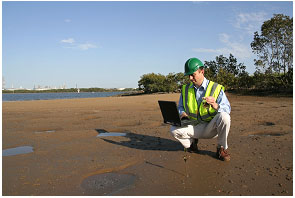Careers: Environmental

Description:
A career in environmental health physics could take you to many out-of-the-way places. Working for a company (like a nuclear power plant, a research laboratory, or a manufacturing firm) that must monitor its water and airborne effluents for radioactive materials, you may find yourself in the woods collecting samples from streams, on a rooftop sampling ventilation stacks, or in a field monitoring soil contamination. You might work at a desk for a government or regulatory agency that confirms reports that companies submit. You might also work for a consulting firm that has been hired to clean up an area (or confirm that it has been cleaned up) where radioactive materials were handled or stored, which could take you around the United States or even overseas.
A health physicist is an important member of an environmental team, providing guidance in sampling and data analysis, protecting the public and the environment from exposure to radiation, and ensuring compliance with scientific standards and government regulations.
Requirements for the Following Positions in an Environmental Setting1:
Environmental Health Physicist
Varies but typically a minimum of a BS in health physics, environmental science, or a related science; preference given to those with an MS and ABHP certification.
Environment, Safety, and Health (ES&H) Technician
Minimum of a high school diploma.
Average Annual Salary: $93,6002
Starting Salary: $41,000
Example Agencies/Companies
- SBC Global
- Environmental Protection Agency
- Cabrera Services
Ask Linnea Wahl, CHP, Technical Writer/Editor, about an environmental career.
Download this page as a pdf.
1This is an example only. Some companies may require graduate degrees.
2Increases by $19,000 per year with certification by the American Board of Health Physics.



